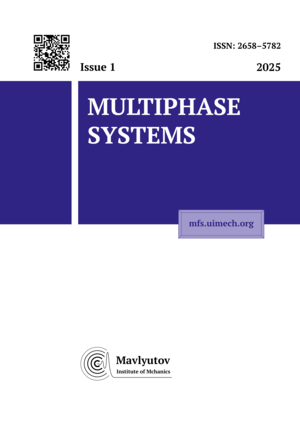

The equations of a motione of the ideal gas admit the proportional dilatation by all independent variables. The invariant stationary submodel of the rank 3 corresponds to this group. All automodeling solutions of the submodel with the linear field of velocities are obtainted. It is possible motiones of particales along quasiraies, on the plane exponential and spiral trajectories, by twisted curves on the rotation surface of the exponential curve.
equations of gas dynamics,
proportional dilatation,
invariant automodeling submodel,
linear field of velocities,
quasiray
The group analysis of the differential equations of gas dynamics gives a big number of submodels: invariant, partial invariant, differential invariant for dissimilar subgroups of the 11- parametric Galilei group extended by the uniform dilatation admitted model. Submodels, even so invariant, are not all good investigated. The solutions with the linear field of velocities are relative to the type of differential invariant submodels as the range of the first derivatives of a velocity by coordinates are invariant over admitted group. This differential invariant submodel is defined by the big order system of the ordinary differential equations. It inherits the admitted group therefor it has integrals but to obtain of the general solution do not present of possible. It has meaning to look for the solutions with the linear field of velocities for submodels.
Objective. By way of illustration to obtain the general solution with the linear field of velocities let us consider the auto-modelling invariant submodel of rank 3 for the dilatation group. The submodel has a stationary type with a constant matrix of the linear field of velocities. The submodel admits the translations and the rotations by the independent variables therefor the constant matrix is equivalent two Jordan forms.
Methods. We obtain the solutions of the compatibility conditions of the auto-modelling submodel with the linear field of velocities depending on the eigenvalues of this matrix. The solutions give the particles motions for the spatial gas state equations.
Results. If the eigenvalues of a nondegenerate matrix are real and do not equal to -1 then from the compatibility conditions it follows the all eigenvalues are equal and the gas is polytropic. The particles motions are isentropic and space radial. If one from the real eigenvalues is equal to -1 then the compatibility conditions give the isentropic two-dimensional radial motion of particles. If two the real eigenvalues are equal to -1 then the compatibility conditions give a one-dimensional isentropic auto-modelling motion. If all 3 the real eigenvalues are equal to -1 then we obtain the isobaric rest in which the density and the entropy are distributed by the conic law.
If the nondegenerate matrix has the complex conjugate eigen values then it is possible the solution with the real eigenvalue -1/2. We obtain the isentropic motion of the monatomic gas with a particle trajectory as the logarithmic spiral on a cone. If the real eigenvalue is -1 then we obtain the polytropic gas motion with a variable entropy and the plane motion along the logarithmic spiral.
The degenerate matrix of the linear field of velocities has null eigenvalue. If it has multiplicity 3 then me obtain isentropic gas motion with the linear state equation on the density. The particle trajectory is the quasi-ray on a half-plane. If the null eigenvalue has the multiplicity 2 then it is possible the solution with the eigenvalue is not equal -1. It gives the isentropic motions of particles on the half-plant on the graph of an exponential function in the cylindrical system of coordinate. If the third eigenvalue is equal -1 then the motion is isentropic and isobaric along rays with the constant velocity. Let null eigenvalue is simple and two real different ones are equal and isn’t -1. We obtain isentropic particle motions in the half-plane on the exponential trajectories. If the real eigenvalues (one or both) are equal -1 then the particle moves on the plane exponential trajectory or along axis. If the matrix has the null eigenvalue and tow complex conjugate ones then it is possible the solution with the spatial state equations and a variable entropy. The particle trajectory is the logarithmic spiral on the exponential surface of the rotation.
Conclusions. We consider all cases of the state equations for which it exists the solutions with the linear field of velocities for the auto-modeling submodel of the gas dynamics equations. It is possible the particles motions along rays and quasi- rays, on the plane exponential and spiral trajectories, by twisted curves on the rotation surface of the exponential curve. These solutions are differential invariant for the gas dynamics equations as ideal so with a constant viscosity.
